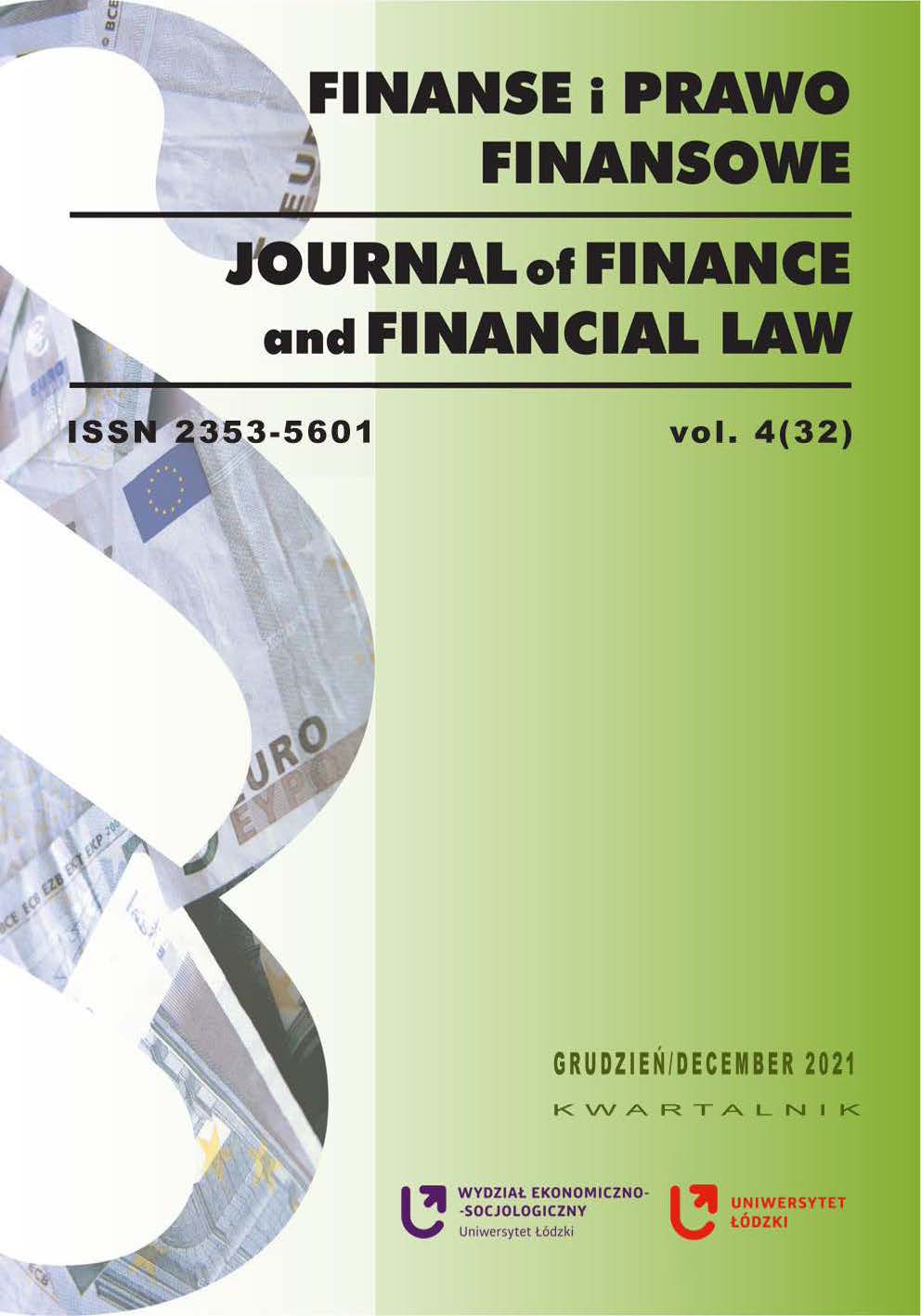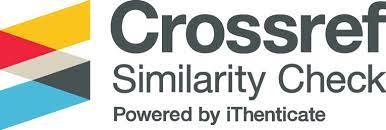Review of the Use of the Countercyclical Capital Buffer in the Eea in Response to the SARS-CoV-2 Virus Pandemic Outbreak
DOI:
https://doi.org/10.18778/2391-6478.4.32.04Keywords:
Countercyclical capital buffer, economic crisis, macroprudential policy, COVID-19Abstract
The purpose of the article is to verify how the SARS-CoV-2 virus pandemic outbreak influenced the decisions to apply the countercyclical capital buffer in the EEA and whether, based on the experience gained so far in applying the countercyclical capital buffer in the EEA, it is possible to clearly distinguish between the models of its application.
Methodology used to achieve this, was to built the field of research and to perform a comparative analysis of macroeconomic data on the application of the above-mentioned instrument in the EEA during the COVID-19 pandemic crisis.
Results of the research are two methods and two variants of the application of the countercyclical capital buffer that were distinguished and named, indicating the benefits and challenges of using each of them. Moreover, the limited usefulness of the standardized and additional gap was confirmed in the light of the conducted research, available in the literature. The article concludes with recommendations for further research.
Downloads
References
BAFIN, (2021a). Countercyclical capital buffer: BaFin does not plan to increase the buffer rate this year, https://www.bafin.de/SharedDocs/Veroeffen-tlichungen/EN/Meldung/2021/meldung_2021_02_26_Antizyklischer_Kapitalpuffer_en.html [dostęp 05.06.2021].
Google Scholar
BAFIN, (2021b). Countercyclical capital buffer, https://www.bafin.de/EN/Aufsicht/Banken-Finanzdienstleister/Eigenmittelanforderungen/Kapitalpuffer/antizyklischer_kapital-puffer_artikel_en.html [dostęp 11.06.2020].
Google Scholar
Barrel, R., Karim, D. and Macchiarelli, C. (2020). Towards an understanding of credit cycles: do all credit booms cause crises? European Journal of Finance, 26(10), pp. 978–993.
Google Scholar
DOI: https://doi.org/10.1080/1351847X.2018.1521341
BIS, (2017). Range of Practices in Implementing the Countercyclical Capital Buffer Policy, https://www.bis.org/bcbs/publ/d407.pdf [dostęp 07.06.2021].
Google Scholar
BNB, (2020a). Press release, https://www.bnb.bg/BankSupervision/BSCapitalBuffers/BSCB-PressReleases/PR_20200623_CCB_EN [dostęp 01.06.2021].
Google Scholar
BNB, (2020b). Press release, https://www.bnb.bg/BankSupervision/BSCapitalBuffers/BSCB-PressReleases/PR_20200929_CCB_EN [01.06.2021].
Google Scholar
BNB, (2020c). Press release, https://www.bnb.bg/BankSupervision/BSCapitalBuffers/BSCB-PressReleases/PR_20201217_CCB_EN [01.06.2021].
Google Scholar
BNB, (2021). Press release, https://www.bnb.bg/BankSupervision/BSCapitalBuffers/BSCB-PressReleases/PR_20210330_CCB_EN [01.06.2021].
Google Scholar
BOE, (2021a). Financial Stability, https://www.bankofengland.co.uk/financial-stability#ccyb [dostęp 05.06.2021].
Google Scholar
BOE, (2021b). Financial Policy Summary and Record of the Financial Policy Committee Meeting on 11 March 2021, https://www.bankofengland.co.uk/-/media/boe/files/financial-policy-summary-and-record/2021/march-2021.pdf [dostęp 05.06.2021].
Google Scholar
Borio, C. (2020). The Covid-19 economic crisis: dangerously unique. Business Economics, 55, pp. 181–190.
Google Scholar
DOI: https://doi.org/10.1057/s11369-020-00184-2
CBI, (2021). CCyB rate announcement February 2021, https://www.centralbank.ie/docs/default-source/financial-system/financial-stability/macroprudential-policy/countercyclical-capital-buffer/ccyb-rate-announcement-february-2021.pdf [dostęp 05.06.2021].
Google Scholar
CNB, (2020a). Statement of the Bank Board for the press conference following the monetary policy meeting, https://www.cnb.cz/en/monetary-policy/bank-board-decisions/CNB-Board-decisions-1585237680000/?tab=statement [dostęp 11.06.2020].
Google Scholar
CNB, (2020b). CNB leaves countercyclical capital buffer rate at 0.50%, https://www.cnb.cz/en/cnb-news/press-releases/CNB-leaves-countercyclical-capital-buffer-rate-at-0.50/ [dostęp 31.05.2021].
Google Scholar
CNB, (2020c). CNB Board decision on financial stability, https://www.cnb.cz/en/financial-stability/cnb-board-decision/CNB-Board-decision-on-financial-stability-1606402260000/ [dostęp 31.05.2021].
Google Scholar
CNB, (2021a). CNB leaves countercyclical capital buffer rate at 0.50%, https://www.cnb.cz/en/cnb-news/press-releases/CNB-leaves-countercyclical-capital-buffer-rate-at-0-00001.50/ [dostęp 31.05.2021].
Google Scholar
CNB, (2021b). Provision of a general nature II/2021, https://www.cnb.cz/en/financial-stability/macroprudential-policy/the-countercyclical-capital-buffer/provision-of-a-general-nature-on-setting-the-countercyclical-capital-buffer-rate/Provision-of-a-general-nature-II-2021/ [dostęp 30.05.2021].
Google Scholar
Deryugina, E., Ponomarenko, A. and Rozhkova, A. (2020). When are credit gap estimates reliable? Economic Analysis and Policy, 67.
Google Scholar
DOI: https://doi.org/10.1016/j.eap.2020.07.009
Dobrzańska, A. (2020). Polityka makroostrożnościowa w czasie pandemii. Bezpieczny Bank, 4(81), ss. 136.
Google Scholar
Dobrzańska, A. i Kurowski, Ł. (2019). CCyB jako instrument polityki makroostrożnościowej. Dotychczasowe doświadczenia w UE. Bezpieczny Bank, 1(74), ss. 8–42.
Google Scholar
Dyrektywa Parlamentu Europejskiego i Rady (UE) 2019/878 z dnia 20 maja 2019 r. zmieniającą dyrektywę 2013/36/UE w odniesieniu do podmiotów zwolnionych, finansowych spółek holdingowych, finansowych spółek holdingowych o działalności mieszanej, wynagrodzeń, środków i uprawnień nadzorczych oraz środków ochrony kapitału, Dz.Urz. UE L 150 z dnia 07.06.2019, s. 253, z późn. zm.
Google Scholar
ERRS, (2017). Financial Stability Implications of IFRS 9, https://www.esrb.europa.eu/pub/pdf/reports/20170717_fin_stab_imp_IFRS_9.en.pdf [dostęp 07.06.2021].
Google Scholar
ERRS, (2021). Countercyclical capital buffer, https://www.esrb.europa.eu/national_policy/ccb/shared/data/esrb.ccybd_CCyB_data.xlsx [dostęp 07.06.2021].
Google Scholar
Finansinspektionen, (2020). FI lowers the countercyclical capital buffer to zero, https://www.fi.se/en/published/press-releases/2020/fi-lowers-the-countercyclical-capital-buffer-to-zero/ [dostęp 11.06.2020].
Google Scholar
Finansinspektionen, (2021). Countercyclical buffer rate, https://www.fi.se/conten-tassets/2813f977246d4fa8b861d5e2c7a931a9/kontracykliskt-buffertv-buffertriktv-kv1-2021eng.pdf [dostęp 05.06.2021].
Google Scholar
Galan, J.E. and Mencia, J., (2021). Model-based indicators for the identification of cyclical systemic risk. Empirical Economics.
Google Scholar
DOI: https://doi.org/10.1007/s00181-020-01993-2
Giese, J., Andersen, H., Bush, O., Castro, C., Farag, M. and Kapadia, S., (2014). The credit-to-GDP gap and complementary indicators for macroprudential policy: Evidence from the UK. International Journal of Finance and Economics, 19(1), pp. 25–47.
Google Scholar
DOI: https://doi.org/10.1002/ijfe.1489
HCSF, (2021). Press Release, https://www.economie.gouv.fr/files/files/directions_services/hcsf/HCSF_20210318_CP_ENG.pdf [dostęp 05.06.2021].
Google Scholar
NBB, (2021). Quarterly decision of the National Bank of Belgium on the countercyclical buffer rate for 2021Q2: 0%, https://www.nbb.be/doc/cp/eng/2021/20210331_bufferrate_2021q2.pdf [dostęp 05.06.2021].
Google Scholar
NBS, (2020a). Quarterly Commentary on Macroprudential Policy April 2020, https://www.nbs.sk/_img/Documents/_Dohlad/Makropolitika/WEB_Stvrtrocny_komen-tar_2020_April-TRA-EN.pdf [dostęp 10.06.2020].
Google Scholar
NBS, (2020b). Quarterly Commentary on Macroprudential Policy July 2020, https://www.nbs.sk/_img/Documents/_Dohlad/Makropolitika/WEB_Stvrtrocny_komentar_2020_July-TRA-EN.pdf [dostęp 31.05.2020].
Google Scholar
NBS, (2021). Macroprudential Commentary March 2021, https://www.nbs.sk/_img/Documents/_Dohlad/Makropolitika/WEB_Makroprudencialny_komentar_2021_April-TRA-EN.pdf [dostęp 31.05.2021].
Google Scholar
Pfeifer, L. and Hodula, M., (2021). A profit-to-provisioning approach to setting the countercyclical capital buffer. Economic Systems, 45(1).
Google Scholar
DOI: https://doi.org/10.1016/j.ecosys.2021.100853
Porozumienie o EOG, Dz.Urz. UE. L. z 1994 r., nr 1, s. 3 z późn. zm.
Google Scholar
Pyka, I., Zygierewicz, M., Bolibok, P. i Nocoń, A. (2019). Polityka makroostrożnościowa w regulowaniu stabilności sektora bankowego. Katowice: Wydawnictwo Uniwersytetu Ekonomicznego w Katowicach.
Google Scholar
Regjeringen, (2020a). Reduction of the countercyclical buffer, https://www.regjeringen.no/en/aktuelt/reduction-of-the-countercyclical-buffer/id2693388/ [dostęp 11.06.2020].
Google Scholar
Regjeringen, (2020b). Countercyclical buffer unchanged, https://www.regjeringen.no/en/aktuelt/countercyclical-buffer-unchanged/id2714522/ [dostep 30.05.2021].
Google Scholar
Regjeringen, (2020c). Countercyclical buffer unchanged, https://www.regjeringen.no/en/aktuelt/countercyclical-buffer-unchanged2/id2765822/ [dostęp 30.05.2021].
Google Scholar
Regjeringen, (2020d). Countercyclical buffer unchanged, https://www.regjeringen.no/en/aktuelt/countercyclical-buffer-unchanged3/id2814810/ [dostęp 30.05.2021].
Google Scholar
Regjeringen, (2021). Countercyclical buffer unchanged Q1 2021, https://www.regjeringen.no/en/ak-tuelt/countercyclical-buffer-unchanged-q1-2021/id2839216/ [dostęp 30.05.2021].
Google Scholar
Reigl, N. and Uusküla, L. (2021). Alternative frameworks for measuring credit gaps and setting countercyclical capital buffers. Journal of Financial Economic Policy, 13(2), pp. 161–179.
Google Scholar
Rizwan, M.S., Ahmad, G. and Ashraf, D. (2020). Systemic risk: The impact of COVID-19. Finance Research Letters, 36.
Google Scholar
DOI: https://doi.org/10.1016/j.frl.2020.101682
Rozporządzenie Parlamentu Europejskiego i Rady (UE) 2019/876 z dnia 20 maja 2019 r. zmieniające rozporządzenie (UE) nr 575/2013 w odniesieniu do wskaźnika dźwigni, wskaźnika stabilnego finansowania netto, wymogów w zakresie funduszy własnych i zobowiązań kwalifikowalnych, ryzyka kredytowego kontrahenta, ryzyka rynkowego, ekspozycji wobec kontrahentów centralnych, ekspozycji wobec przedsiębiorstw zbiorowego inwestowania, dużych ekspozycji, wymogów dotyczących sprawozdawczości i ujawniania informacji, a także rozporządzenie (UE) nr 648/2012, Dz.Urz. UE L 150 z dnia 07.06.2019, s. 1, z późn. zm.
Google Scholar
Rubio, M. and Carrasco-Gallego J.A. (2016). The new financial regulation in Basel III and monetary policy: A macroprudential approach. Journal of Financial Stability, 26, pp. 294–305.
Google Scholar
DOI: https://doi.org/10.1016/j.jfs.2016.07.012
Rubio, M. and Yao, F. (2020). Bank capital, financial stability and Basel regulation in a low interest-rate environment. International Review of Economics & Finance, 67, pp. 378–392.
Google Scholar
DOI: https://doi.org/10.1016/j.iref.2020.02.008
Solarz, J.K. i Waliszewski, K. (2020). Całościowe zarządzanie ryzykiem systemowym. Pandemia COVID-19. Kraków: Wydawnictwo edu-Libri.
Google Scholar
Traktat ustanawiający Europejską Wspólnotę Gospodarczą, Dz.U. 2004, nr 90, poz. 864/2 z późn. zm.
Google Scholar
Umowa o wystąpieniu Zjednoczonego Królestwa Wielkiej Brytanii i Irlandii Północnej z UE i Europejskiej Wspólnoty Energii Atomowej, Dz.U. UE. C. z 2019 r., s. 144.
Google Scholar
Ustawa z dnia 25 lutego 2021 r. o zmianie ustawy – Prawo bankowe oraz niektórych innych ustaw, Dz.U. 2021, poz. 680.
Google Scholar
Zalecenie Europejskiej Rady ds. Ryzyka Systemowego z dnia 18 czerwca 2014 r. w sprawie wytycznych dotyczących ustalania wskaźników bufora antycyklicznego, Dz.Urz. UE C 293/1 z dnia 02.09.2014.
Google Scholar
Downloads
Published
How to Cite
Issue
Section
License

This work is licensed under a Creative Commons Attribution-NonCommercial-NoDerivatives 4.0 International License.














